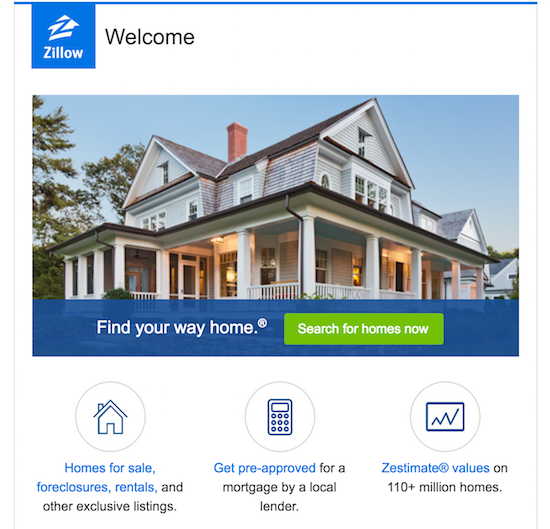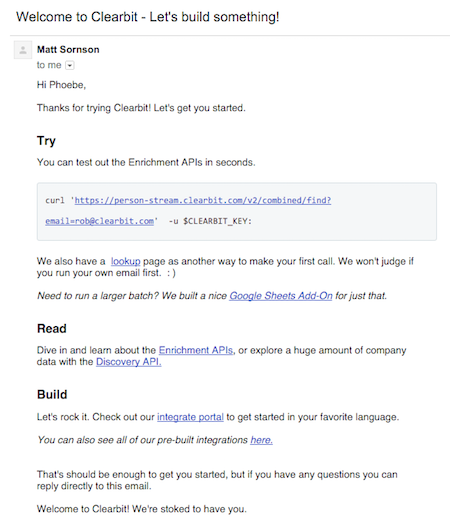Lessons from an Epic Analysis of 50 Welcome Emails
By Janet Choi
Source: CustomerIO
How do you create a valuable welcome email? The “Hello! Hi! Welcome!” part is clear enough, but what else should you consider?
Welcome emails aren’t just a formality but a crucial opportunity. Minutes before, your customer was excited enough about your service to sign up for an account. A good welcome email capitalizes on the momentum of that sign-up, rewarding customers for their behavior and enticing them to stay engaged.
We analyzed 50 welcome emails to figure out how to best guide customers along their customer journey. Let’s dive into the data we found.
The Anatomy of a Welcome Email
We looked at welcome emails from 50 subscription services, with a mix of B2B and B2C. We learned that every good welcome email has these three things:
- Welcome Message. This is where you welcome, invite, and inform your customer. (Tip: use the goof-proof Princess Bride welcome copywriting formula!)
- Images. Appeal to visual learners and provide brand context.
- A call-to-action. Invite your customers to start getting value from your service. For example, if a customer just signed up for your survey tool, you’d invite them to make a survey.
Check out this welcome email for Dropbox Teams, which includes all three components.

- The welcome text explains your new benefits now that you’ve signed up.
- The image breaks up the text, makes the email visually appealing, and promotes the message of collaboration.
- The call-to-action prompts you to “Get started” in Dropbox Teams with a clear next step.
Let’s dig into some of the data to discover best practices for each component.
Welcome Text: Engage Your Customers Immediately—Or Lose Them
A study from the Nielson Group about email newsletters showed that recipients only allocated about 51 seconds to read each email, and often just glanced at the content.
Even though newsletters don’t serve the same purpose as welcome emails, the takeaway is the same: no one will pore over your email’s flowery language. Customers should get your most valuable information right away, from day one, and that can help retain them down the road.
Optimize your word count
In our findings, a good majority (65.4%) of welcome emails had between 50 and 150 words. About a quarter of the emails were over 150 words.
The variation in copy length makes sense—the amount of text you use depends on what you have to convey to new users. It can take longer to explain to someone how they can generate leads than it might to show them a dress to buy.
Despite the variation, it’s possible to be both concise and thorough. This email from Zillow, coming in at only 32 words, is a good model. It has all the component parts (welcome text, image, CTA), and explains all of Zillow’s core functions (home listings, mortgage pre-approval, and “zestimating”).

Personalize your message to increase conversion rates
Personalization improves click-through rates. And most marketers claim to prioritize personalization.
In our analysis, we looked for two types of personalization:
- Name personalization: Think “Hi, Ellen!” or “Welcome, Jake!”
- Content personalization: Tailoring content based on information you have about a customer, like whether a customer downloaded your productivity tool for business or personal use.
For name personalization, only 11 out of the 50 emails we analyzed used our names (or usernames) in the greeting. That’s just 22%.
It’s not hard to address your customers by name, as long as you’ve got that information. And because personalization tends to increase conversions, any little effort is worth trying.
In terms of content personalization, we found that none of the emails we received were personalized based on use personas. Because few companies are doing this, this is an opportunity to make your welcome emails exceptional.
Clearbit, a business intelligence tool, gathers data to determine their customers’ job roles and sends different welcome messages based on those roles. A new user’s job affects how they approach and use Clearbit’s products.
Here’s a marketer-focused welcome, offering integrations with tools they’re likely to already use and calling out the potential to “becoming a marketing god.”


In the case of a welcome email (and many other lifecycle messages), the text aims to invite customers to engage in some way, so you have to make that invitation appealing. And different elements of your service or ways to frame your message can effectively appeal to different segments of people.
Images: Use Graphics to Help Customers Understand Your Brand
